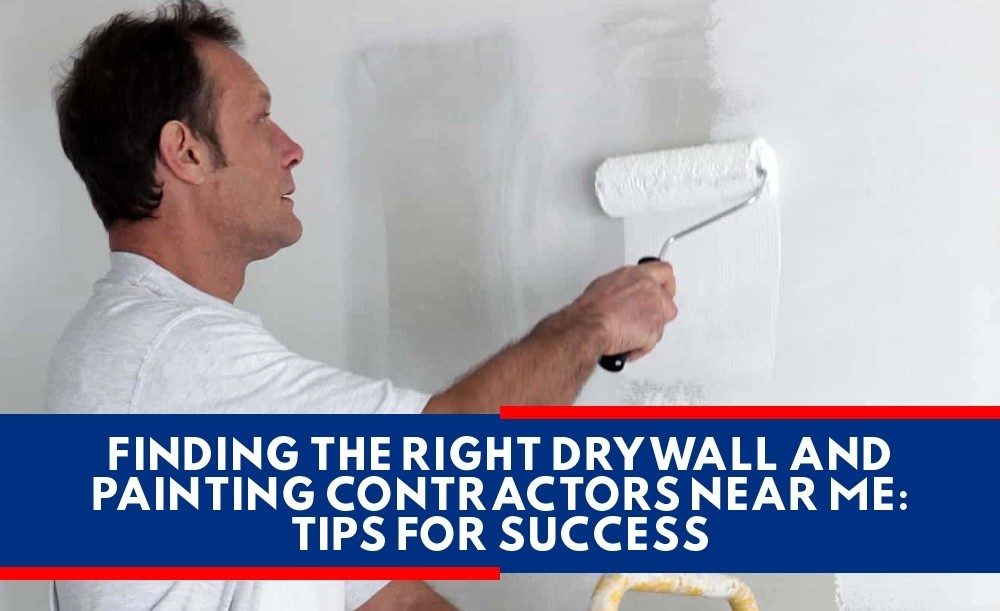Drywall Repair Cost: Understanding the Factors That Affect Your Bill
DIY Drywall Repair: A Step-by-Step Guide to Fixing Common Issue

Table of Contents
DIY drywall repair is an intimidating task, but it doesn't have to be! With the right tools and guidance, anyone can take on this home improvement project with confidence. In this article, we'll provide a step-by-step guide to fixing common issues that arise when repairing drywall.
Most homeowners find themselves in need of drywall repairs at some point or another - from small holes left behind by doorknobs to gaping cracks caused by water damage. Knowing how to address these problems properly can save time, money, and frustration in the long run.
By following a few basic steps, you can save yourself a lot of money and stress by avoiding professional services. Furthermore, do your research beforehand; you’ll want to ensure that the drywall repair contractor you choose is experienced and equipped with the necessary licenses and qualifications for the job.
It's a common experience, one we've all been through - waking up to find drywall damage in our homes. Whether it was an accidental bump or the result of something more serious, fixing drywall can be intimidating and overwhelming. But don't worry - with the right materials and some patience, you too can make your walls look as good as new!
Joint compound, drywall screws, and a drywall knife are essential items for any DIYer tackling this project. A joint compound is used to fill cracks and gaps while also sealing the wall before painting. Drywall screws will help secure pieces of damaged drywall back into place. And finally, a drywall knife can come in handy when spreading joint compound over large areas or scraping away excess material after repairs have been made.
DIY home improvement projects are a great way to save money, as well as learn new skills. When it comes to drywall repair, the process is relatively straightforward, and if done correctly can result in substantial savings on drywall repair costs. To get started, begin by gathering the necessary supplies such as joint compound and sandpaper. With these materials in hand, you'll be ready to begin the repair process with confidence – empowering you to tackle any minor issues around the house with ease!
Before you can begin patching any holes in the drywall, it's important to properly prepare the wall. This will help ensure a successful repair and prevent further damage down the line. Here are three essential steps to take when preparing your drywall for repairs:
Start by cleaning up any loose material from around the damaged area. Use a vacuum or broom to remove dust and debris before doing anything else.
Apply joint tape along all edges of the hole or crack. The joint tape helps keep moisture out while also providing extra reinforcement for holding the compound in place.
Wear a dust mask to protect yourself from inhaling particles as you sand down any rough spots on the drywall surface with a fine-grit sandpaper.
With these simple preparations taken care of, you’re now ready to start patching those pesky holes in no time!
Finally, it's time to patch those pesky holes. It may seem like a daunting task at first, but with the right tools and a bit of patience, you can easily repair drywall back to its original state. Let’s get started!
To begin, gather all the items needed for the job: a putty knife, hot water, sandpaper or fine-grit steel wool, joint compound (also known as "mud"), and finally a pre-cut drywall patch. With these materials in hand, you will be able to complete this project in no time.
Once everything is ready to go, start by wetting the damaged area lightly with hot water from a spray bottle. This will help soften up any hardened mud so that it can be more easily removed before applying a new layer. Then, use your putty knife to scrape away any loose material until only a smooth wall remains. After that has been taken care of, apply the drywall patch over the hole and press it firmly against the wall surface using your hands or an adhesive spreader tool. Finally, cover up any remaining gaps with the joint compound and let it dry overnight.
The last step is simple yet crucial—sand down any rough areas once they have dried completely. Doing this gives you a professional-looking finish that blends seamlessly into existing walls without being noticeable!
Filling cracks in drywall is a common issue that can be easily fixed with the right tools and techniques. Fortunately, this project isn't too complicated and should only take an hour or two of your time!
To begin, gather all the necessary materials: a putty knife, sandpaper or fine-grit steel wool, joint compound (also known as 'mud'), and finally a pre-cut drywall patch. With these items ready to go, you'll be able to repair any cracked walls in no time.
The key to successful crack repairs lies in creating flat surfaces on either side of the crack. Start by using your putty knife to scrape away any loose material until only a smooth wall remains. Then use sandpaper or steel wool to ensure both sides are free from debris and leveled out evenly.
Once you’ve achieved this step, it's time for the fun part—applying the drywall joint compound over the entire area using a wide-spreader tool. Make sure each layer is completely dry before adding another so that everything bonds together properly! Finally, cover up any remaining gaps with more joint compound until everything looks even and consistent throughout.
With just a few simple steps, your cracked walls will look like new once again!
The common theory is that damaged corners are difficult to repair, but in actuality, the process of repairing them isn't as daunting as it might seem. With the right tools and techniques, you'll be able to patch up any corner damage with relative ease!
It's time to give your wall a fresh face—both literally and figuratively! Begin by cleaning off the surface with a drywall knife or sandpaper until it's smooth. Next, apply joint compound, using a wide spreader tool and making sure each layer is dry before adding another. To finish things off, apply lightweight drywall compound to any remaining gaps and use drywall screws along with some more joint compound to make sure everything is even and consistent. Finally, use a damp cloth to clean away any dust from the lightweight joint compound. Now that you've done all that work, your corner will look like new again!
Now that you've got the hang of repairing damaged corners, what about replacing larger sections of drywall? This is a more involved job, but with patience and some elbow grease, it can be done!
Start by using a drywall knife to cut out any areas that are severely damaged or not salvageable. If there's only minor damage, use joint compound and paper tape to patch up the affected area—make sure each layer is completely dry before adding another so everything bonds together properly. Once that's completed, mix your drywall mud according to manufacturer instructions. Then apply a thin coat over the patched area with either a wide spreader tool or putty knife until it's completely covered. Let this layer completely dry before continuing.
Afterward, add subsequent layers of mud to create an even surface—use light strokes when applying these layers as too much pressure could cause them to crack after drying. When that’s finished, sand down the entire area to make sure everything is smooth and consistent throughout. With all repairs made and dried correctly, you'll have successfully replaced large sections of drywall without having to replace the whole sheet!
When it comes to DIY drywall repair, the devil is in the details—and that's especially true when it comes to texturing. Whether you're patching up a wall or ceiling, creating an even texture will bring your repairs from "meh" to masterful!
First off, grab yourself a four-inch drywall knife and start cutting away any loose bits of paper around the patched area. Then use joint compound and mesh tape to fill in any holes or crevices before sanding down with coarse-grit drywall sandpaper until everything looks smooth and flush. Once all of this prep work is done, here are some of the most popular textures used for ceilings:
• Popcorn – A bumpy surface created by spraying on layers of stucco material
• Knockdown – Applying thinned joint compound onto a flat surface then flattening out bumps with a trowel after drying
• Orange Peel - Spraying on multiple layers of joint compound until a light “orange peel” texture appears
• Sand Swirl - Using a wide brush dipped into the joint compound while rotating it in circles across the ceiling
After choosing your desired texture style, make sure each layer has completely dried before adding another coat. This step takes patience but can add value to your home if completed correctly. With all steps finished and dried properly, you'll be ready to move on to sanding and finishing!
Now that you’ve finished texturing, it’s time to move on to the final step: sanding and finishing. Sanding is an important part of any drywall repair job, as it helps create a smooth surface for paint or wallpaper. Depending on the texture you used, there are several tools you can use for sanding.
For popcorn textures, start with a medium-grit sandpaper block and work your way up to fine grit until everything looks even. For knockdown and orange peel textures, you can use either a hand sander with finer grit paper or a power sander with a 120-grit screen attachment. Finally, if you choose a sand swirl texture be sure to have plenty of elbow grease handy—you'll need it to get those ridges extra smooth!
Once all surfaces have been properly sanded down, grab yourself some drywall mud to fill in any divots left behind by nails or screws. Using a damp sponge then lightly feather out the area around each hole before leaving them overnight to set. After these repairs are complete, simply apply one more light coat of joint compound followed by another round of sanding with ultra-fine grit paper and you're done! Now, all that's left is applying primer and your choice of finish color; whether it's paint or wallpaper you've now got the perfect backdrop for making memories at home!
Author

Mason Marquis, raised in Newport Beach, California, and Austin, Texas, amalgamated his experiences from both vibrant cities in his journey. His academic pursuit in Economics and Psychology at the University of North Texas (UNT) led to the founding of Spray Tex Painting. This venture was not just a business for Mason but a practical application of his academic learnings, particularly the integration of economic concepts and psychological understanding. Spray Tex Painting, under Mason's direction, transcends being merely a painting service; it's a platform where client visions are realized through dedication and creativity.
Related Articles

Drywall Repair Cost: Understanding the Factors That Affect Your Bill

Finding the Right Drywall and Painting Contractors Near Me: Tips for Success

How to Get an Accurate Quote from Drywall Repair Contractors

Painting and Drywall Repair: Coordinating Your Projects for the Best Results